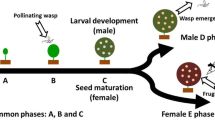Summary
I review the status of five topics in fig research: pollen-vector versus seed production, flowering phenology and wasp population dynamics, monoecy versus dioecy, parasite pressure, and fig wasp behavior. I raise several new questions based on recent research on two components of fig reproduction: pollen-donation (male) and seed-production (female) success. I focus on how these two components of reproductive success depend on the flowering phenology of the figs and the population dynamics of the pollinator wasps.
Similar content being viewed by others
References
Avila, M. V., Figs and fig-wasps native to south Florida and their affinities: biogeography and taxonomy. (1989) manuscript.
Berg, C. C., Classification and distribution ofFicus. Experientia45 (1989) 605–611.
Bouček, Z., Watsham, A., and Wiebes, J. T., The fig wasp fauna of the receptacles ofFicus thonningii (Hymenoptera, Chalcidoidea), Tijdschr. Ent.124 (1981) 149–233.
Bronstein, J. L., Coevolution and Constraints in a Neotropical Fig-Pollinator Wasp Mutualism. Ph. D. Dissertation, University of Michigan, Ann Arbor 1986
Bronstein, J. L., Fruit production in a monoecious fig: consequences of an obligate mutualism. Ecology69 (1988) 207–214.
Bronstein, J. L., A mutualism at the edge of its range. Experientia45 (1989) 622–637.
Frank, S. A., Theoretical and Empirical Studies of Sex Ratios, Mainly in Fig Wasps. Master's Thesis, University of Florida, Gainesville 1983.
Frank, S. A., The behavior and morphology of the fig waspsPegoscapus assuetus andP. jimenezi: descriptions and suggested behavioral characters for phylogenetic studies. Psyche91 (1984) 289–308.
Frank, S. A., Hierarchical selection theory and sex ratios. II. On applying the theory, and a test with fig wasps. Evolution39 (1985) 949–964.
Frank, S. A., Are mating and mate competition by the fig waspPegoscapus assuetus (Agaonidae) random within a fig? Biotropica17 (1985) 170–172.
Galil, J., Dulberger, R., and Rosen, D., The effects ofSycophaga sycomori L. on the structure and development of the syconia inFicus sycomorus L. New Phytol.69 (1970) 103–111.
Godfray, H. C. J., Virginity in haplodiploid populations: a study on fig wasps Ecol. Ent.13 (1988) 283–291.
Grant, P. R., Convergent and divergent character displacement. Biol. J. Linn. Soc.4 (1972) 39–68.
Grant, P. R., Ecology and Evolution of Darwin's Finches, Princeton University Press, Princeton 1986.
Hamilton, W. D., Extraordinary sex ratios. Science156 (1967) 477–488.
Hamilton, W. D., Wingless and fighting males in fig wasps and other insects, in: Sexual Selection and Reproductive Competition in Insects, pp. 167–220. Eds M. S. Blum and N. A. Blum. Academic Press, New York 1979.
Hamilton, W. D., and May, R. M., Dispersal in a stable habitat. Nature269 (1977) 578–581.
Herre, E. A., Sex ratio adjustment in fig wasps. Science228 (1985) 896–898.
Herre, E. A., Optimality, plasticity, and selective regime in fig wasp sex ratios. Nature329 (1987) 627–629.
Herre, E. A., Coevolution of reproductive characteristics in 12 species of New World figs and their pollinator wasps. Experientia45 (1989) 637–647.
Janzen, D. H., How to be a fig. A. Rev. Ecol. Syst.10 (1979) 13–51.
Janzen, D. H., How many parents do the wasps from a fig have? Biotropica11 (1979) 127–129.
Kjellberg, F., La stratégie reproductive du figuier (Ficus carica L.) et de son pollinisateur (Blastophaga psenes L.): un exemple de coévolution. Ph. D. thesis. INAPG, Paris 1983.
Kjellberg, F., Gouyon, P.-H., Ibrahim, M., Raymond, M., and Valdeyron, G., The stability of the symbiosis between dioecious figs and their pollinators: a study ofFicus carica L. andBlastophaga psenes L. Evolution41 (1987) 693–704.
Kjellberg, F., and Maurice, S., Seasonality in the reproductive phenology ofFicus: Its evolution and consequences. Experientia45 (1989) 653–660.
Lachaise, D., Tsacas, L., and Couturier, G., The Drosophilidae associated with tropical african figs. Evolution36 (1982) 141–151.
Michaloud, G., Aspects de la Reproduction des Figuiers Monoïques en Forêt Equatoriale Africaine. Ph. D. Dissertation. Université des Sciences et Techniques du Languedoc. Montpellier, France 1988.
Milton, K., Windsor, D. M., Morrison, D. W., and Estribi, M. A., Fruiting phenologies of two neotropicalFicus species. Ecology63 (1982) 752–762.
Murray, M. G., The closed environment of the fig receptacle and its influence on male conflict in the Old World fig wasp,Philotrypesis pilosa. Anim. Behav.35 (1987) 488–506.
Ramirez, B., Ramirez, W., Coevolution ofFicus and Agaonidae, Ann. Mo. bot. Gdn61 (1974) 770–780.
Ramirez B., Ramirez W., Evolution of mechanisms to carry pollen in Agaonidae (Hymenoptera, Chalcidoidea). Tijdschr. Ent.121 (1978) 279–293.
Ramirez B., Ramirez W., Evolution of the monoecious and dioecious habit inFicus (Moraceae). Brenesia18 (1980) 207–216.
Ulenberg, S. A., The systematics of the fig wasp parasites of the genusApocrypta Coquerel, North Holland Publishing Co., Amsterdam 1985.
Verkerke, W., Anatomy ofFicus ottoniifolia (Moraceae) syconia and its role in the fig-fig wasp symbiosis. Proc. K. ned. Akad. Wet.89 (1986) 443–469.
Verkerke, W., Structure and function of the fig. Experientia45 (1989) 612–622.
Wiebes, J. T., A short history of fig wasp research. Gdns' Bull. Straits Settl.291 (1976) 207–236.
Wiebes, J. T., Co-evolution of figs and their insect pollinators. A. Rev. Ecol. Syst.10 (1979) 1–12.
Windsor, D., Morrison, D. W., Estribi, M. A., and de Leon, B., Phenology of fruit and leaf production by ‘strangler’ figs on Barro Colorado Island, Panama. Experientia45 (1989) 647–653.
Author information
Authors and Affiliations
Rights and permissions
About this article
Cite this article
Frank, S.A. Ecological and evolutionary dynamics of fig communities. Experientia 45, 674–680 (1989). https://doi.org/10.1007/BF01975684
Issue Date:
DOI: https://doi.org/10.1007/BF01975684




